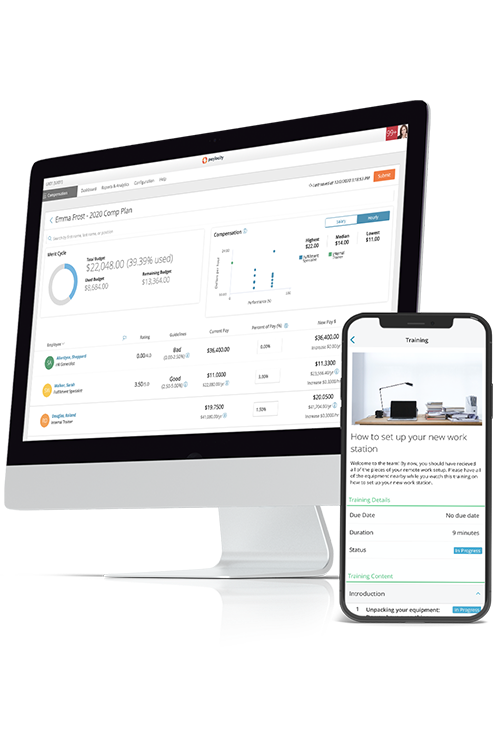resources
Building a Talent Management Philosophy for Organizational Impact
January 05, 2023
A talent philosophy is a set of guidelines that frame talent management & recruitment efforts. Learn how to formulate one for your organization.
Blog Post

When it comes to talent management, you can either become a disruptor or be disrupted. The way we attract, engage, and retain talent is evolving quickly, and HR professionals must develop a talent philosophy that’s agile while still delivering organizational impact.
With 59% of executives agreeing that talent acquisition, development, and retention will be a top challenge in the next five years, there’s no time like the present to learn about talent philosophies and why they’re a must-have for your organization.
What Is Talent Philosophy?
A talent philosophy is a set of guidelines that helps you navigate talent management in your organization, both for existing employees and future hires. It details your company values and ideology regarding how to attract and retain employees. And it includes your organization’s approach to DEIA, talent development strategies, and the role of employee engagement in driving business success.
Your company’s talent philosophy is an important part of its overall business strategy, as it helps ensure the organization has the right people with the right skills and capabilities to support growth and success. Along with guiding the way forward, a talent philosophy is also a key driver of employee retention — and plenty of other HR goals.
Why You Need a Talent Management Philosophy
Because they guide how organizations approach talent management practices like recruiting, onboarding, and employee development, talent philosophies tend to make a positive impact wherever they’re implemented.
Companies with talent philosophies can more effectively scale their businesses, reduce siloed thinking, and create a more consistent employee experience across leaders and departments. These organizations also position HR representatives as strategic partners.
Having a clear talent management philosophy also standardizes an organization’s approach to talent strategy because it acts as a guidebook. Without one, “managers will rely on their personal preferences and bias to guide how they manage and grow their teams,” says Marc Effron, President of The Talent Strategy Group.
But beyond preventing personal biases, there are several reasons why organizations need a talent philosophy to find and keep employees:
- Competition for talent: In today's job market, there’s intense competition for top talent. An organization's talent philosophy can help it stand out and attract the best candidates, as it communicates the organization’s values and priorities to potential employees.
- Retention: Keeping employees on board and engaged is a top priority for most HR professionals. A talent management philosophy that takes employees’ wants into account will drive retention because they will stay interested and loyal. For example, if your talent philosophy emphasizes employee development, research shows they’ll be more likely to stay.
- Creates a positive culture: Today’s employees want to work for organizations that reflect their own values. If your philosophy incorporates key values like diversity, inclusion, and employee engagement, it will create a positive company culture.
- Talent gaps: Do you want your organization to be known as the best in a specific category like “best place to work for moms” or “best place to work for new grads”? What does that mean, and how can you hire appropriately? A talent philosophy can help an organization identify and fill talent gaps, ensuring that it has the skills and capabilities it needs to meet its business objectives.
- Decision making: A talent philosophy provides a framework for making decisions about talent management, including how to evaluate performance, compensate employees, and invest in employee development.
Overall, a talent philosophy is an important tool for attracting and retaining top talent and can help an organization achieve its business goals and stay competitive in the market.
The Five Elements of a Talent Philosophy
Research from The Talent Strategy Group found that there are five elements that comprise a talent philosophy:
- Performance: How will leaders respond to high or low employee performance? What are the consequences and rewards?
- Behaviors: How much do employee behaviors matter, and at what threshold does the organization start to care about those behaviors?
- Differentiation: How much should the organization invest in leadership development for its highest performers versus its average potential leaders?
- Transparency: How open should the organization be about each employee’s career potential within the company?
- Accountability: To what extent should managers be responsible for building quality and depth of their team?
Creating a talent management philosophy starts with senior leadership and their thought processes regarding development. Keep these elements in mind when creating your own organization’s philosophy.
How to Create a Talent Management Philosophy
Developing and implementing a talent management philosophy is relatively straightforward, given that stakeholders can agree on their desired outcomes. Once your organization is aligned, you can start infusing the philosophy into your talent management strategy, including hiring practices, core competencies, and overall employee development tactics. Follow these steps to build and apply a talent philosophy for your organization.
1. Define Your Goals and Strategy
When you’re ready to build a talent philosophy, start by meeting with leadership and other business stakeholders to identify your organization’s desired outcomes. What are the goals, objectives, and KPIs? What are the strategic priorities?
Then, translate those strategic priorities into talent management practices. Identify the roles and competencies critical to achieving priorities, assess current talent in these roles, and decide how to proceed. Do you want to optimize existing talent, hire new talent, or both? This is also when you’ll identify appropriate talent management practices.
2. Identify Your Culture and Values
Your talent philosophy should reflect your organization’s values and culture. If you haven’t yet developed a workplace culture, it’s important to understand this is a huge undertaking, especially for larger organizations. But it’s worth the effort — companies with strong cultures position themselves to attract and retain employees, and their workforces are happier and more productive.
Take some time to think about what is important to your organization and what kind of work environment you want to create. Your culture should be part of your conversations, your behaviors, your decisions, and your employee experience.
If you’ve already established a set of values, explore how they apply to talent management practices.
3. Determine Your Approach to Talent Management
Based on your business goals and values, determine how you want to approach talent management. This might include your approach to hiring, performance management, employee development, and retention. Start by asking senior leaders these questions to uncover their beliefs on talent:
- Can skills be developed or do employees come into the organization with those skills, education, or training?
- Should we focus our time, effort, and resources on the few top performers or the many solid performers?
- Do these questions apply to all roles and functions in the organization or just some of them?
These beliefs will influence how your organization applies talent management practices, such as sourcing candidates, leadership development, total rewards, and more.
4. Communicate Your Talent Philosophy
Once you’ve developed your talent philosophy, it’s important to communicate it to your employees and potential candidates. This can help attract top talent and ensure that everyone in the organization is aligned with your talent management approach. It’s also worth adding to your employee handbook, so your workforce can revisit it as needed.
5. Review and Revise Your Talent Philosophy
A talent philosophy is not a static document, and it may need to be revised as your business goals and strategy evolve. It’s important to regularly review your talent philosophy and make any necessary updates to ensure it remains relevant and effective. Document management software lets you store key documents like your talent philosophy and digitally distribute updates with ease.
Prioritize Your People
Your organization’s most important resource is your people. Their needs and wants are continually evolving, and their development is key to building a workforce that will support company growth. And with a solid talent management philosophy, your leaders can attract and retain employees with the skills needed to meet company goals.
New hire onboarding best practices; fair pay; diversity, equity, and inclusion; employee development; work evaluation; and empowering performance management are just the beginning to driving job satisfaction every step of the way and improving employee retention.
Paylocity does all of the above and more, helping you prioritize your people and meet the needs of employees in any work environment. Request an HR and payroll software demo to see how it works.

The Tools You Need to Attract and Retain
Embed employee experience features from recruiting, onboarding, and beyond with tools built for the modern workforce. Kick off day one with a welcome message using video. Connect your employees with collaboration tools and peer groups. Develop your team with relevant and interesting training. Keep the conversation going with surveys. And do it all while automating and collecting data to proactively make improvements.


